|
Where to start? The
Chicken or the Egg- the Revolver or the Cartridge? Both the Old Colt
revolver and the .32 S&W Long cartridge have played
important roles in handgun history but are largely ignored by
the popular press. Nevertheless,
they have a cadre of dedicated enthusiasts and become the
subjects of frequent discussion on the Internet boards.
What I have been
shooting is a Colt Police Positive Special - a revolver in
production from 1908 until the late 1970s.
Its antecedents include the Colt New Police of 1896, the
Pocket Positive and the short cylinder Police Positive of 1905.
Its progeny includes the Detective Special and the target
sighted Diamondbacks - sporting revolvers much valued by
collectors and connoisseurs.
It is built on the small .38 platform that, in latter
years, became known as the “D” Frame. All of these revolvers
employ the 1905 vintage “Positive Safety”, a hammer-block
that permits safe carry with all chambers loaded.
It is the most –produced revolver in the Colt line,
encompassing some 750,000 units with room for confusion
occasioned by shared serial numbers.
The
designation “Special” Comes from the lengthened cylinder
which allowed it to house its most popular cartridge - the .38
Special / Colt New Police and incidentally, the 32-20 WCF
cartridge.
What
makes my particular example “Special” is that it is
chambered for the .32 Colt New Police Cartridge.
This is the politically correct name for the .32 Smith
and Wesson Long when chambered in a Colt. Colt did this -
both with the .32 and the .38 Special - named them the “Colt
New Police” to avoid advertising the Smith and Wesson
developments. The Police Positive Special will fire the old .32
S&W cartridge as well as the Long and will not do at all
well with the old .32 Colt and Long Colt Cartridges.
These rounds use the same nominal .312-313 bullet that
are of the full case diameter, heeled variety like the modern
.22 rimfires. Firing
them in 32 S&W Long chambers will over expand the smaller
cases ripping them from Dan to Beersheba in the process.
The .32 S&W and S&W Long cases are too large to
fit in the older Long Colt chambers. This is a good thing.
Another special aspect
of the revolver on hand is its production vintage of 1949-50. It
is a mechanically pristine example of mid-century craftsmanship
and engineering. Its
smooth action, well defined sights and light trigger combined
with a 4” barrel go far toward reducing (but not eliminating)
the difficulty I have in hitting things with small,
pocket-portable revolvers. The features make for pleasurable
casual shooting at moderate ranges. The double action stacks and
feels strange to the shooter used to a Smith and Wesson, but
this revolver proves very accurate in that mode - reliably
bouncing cans out to fifty feet or so.
The
.32 Smith and Wesson Cartridge dates from the late 1870s and was
a ubiquitous presence in the various single and double action
pocket pistols manufactured up until World War II.
The Long variation came along in 1896 with the
introduction of Smith and Wesson’s first hand ejector
revolver. It
received a jump-start as a police cartridge when Commissioner Theodore
Roosevelt acquired the Colt New Police revolver as the
standard arm for the New York City Police Department.
Roosevelt was deeply impressed by the extremely poor
marksmanship of the NYC officers and it seems likely that he
chose the .32 for its light recoil rather than any great regard
for the small bore as Man-Stopper.
Whatever the reasoning, the Colt and Smith .32 Longs were
quickly adopted by several northeastern police agencies and the
cartridge remained a police standard for some time to come.
The round proved very accurate and gained worldwide
acceptance as a target cartridge.
Colt, Smith and Wesson, Charter Arms, Taurus and
others produced substantial numbers of .32 S&W Long /Colt
New Police revolvers right up until the development of the .32
H&R Magnum Cartridge.
In the late 1960s, Dean Grennell experimented with
uploaded rounds in his K 32 while promoting development of a .32
Magnum as a small game cartridge - an event that didn’t take
place until about 20 years later.
In the 60s, handbook entries carried 100- grain bullet
loads up to the 1,000fps mark and into the low-magnum
performance range.
In
the present day, there is a general dearth of truly small-framed
.32 Magnum revolvers and the old quality Colts and small-framed
Smiths continue to cause considerable excitement among handgun
enthusiasts. Even those who like the little revolvers frequently regard it
as a novelty and disparage the .32 Long as a practical round.
Several factors combine however, to give the cartridge an
excuse for being:
-
The
.32 Long Cartridge loaded with fast-burning powder delivers
more on-target energy than the .22 rimfire rounds regardless
of barrel length;
-
The
.32 generally performs more efficiently from the
oft-encountered 3-4” barrels than do the .22 Long Rifle or
Magnum rounds delivering less round to round variation and
often exhibits better accuracy;
-
The .32 Long is
different enough to be different - an important
consideration whenever you get tired of everything being the
same.
My
exploration of the Colt Police Positive Special in .32 Long is
informed by several realities.
On the positive side is the abundance and variety of
reloading components suitable to the cartridge. On the negative
vector, are my personal limitations in regards to actually
hitting anything with a small framed, short barrel revolver. I
address the latter by limiting my expectations to a realistic
practical range for shooting such things as small game and other
targets of opportunity. This would seem to be about 50 feet.
The former factor - the availability of suitable
reloading components - comes into play as I develop loads that
hit reasonably close to the fixed sights at the 50 foot
distance. These loads must group suitably well to dispatch
something the size of a cottontail rabbit.
The
.32 S&W factory loads were accurate enough for government
work but hit several inches low. The same was true of the not-very-accurate Aguilla .32
Long 98-Grain Round Nose. The
PMC version of the same load grouped very well from a
casual field rest at 50 feet and hit an inch or a bit more under
point of aim. Unlike the Aquilla load, the PMC fodder ignited
reliably with no misfires.
I quickly learned that 90-100 grain bullets driven to
slightly over 800 fps would consistently group well under 2”
and hit usefully close to the sights.
The Lyman 3118 115-grain bullet designed for the
32-20 grouped about 1.5” and hit point of aim loaded to just
over 700 fps. I
obtained excellent results from the 100 Meister cast
double-ended wadcutters loaded to 800 fps and got a very decent
1” group from the Hornady HBWC from about 25 yards.
Loading
hollow-based wadcutters reversed often produces profound
expansion in .38 Special revolvers. In .32 and .32 Magnum both the Speer and Hornady
bullets tumble badly when loaded in this manner.
In
a small case like the .32 Long, minor changes in components,
powder charges and loading procedures make a big difference over
the chronograph. Fast-burning
powders clearly show the most consistent velocities. Bullets
that take up a large portion of the case,
like the wadcutters or the long-shank 90-grain
semi-wadcutter from Hornady, likewise produce small shot to shot
velocity variations. It is not particularly hard to produce good, accurate hand
loads in this caliber but the importance of minor variables make
it hard to depend upon published loading data for a reliable
prediction of what your home concocted loads will actually do.
In
my own case, I found that there would not be any particular
advantage in straying from Alliant Bullseye and the
wadcutter bullets from Meister and Hornady.
I’ve
used these bullets loaded to the 800 fps range in both .32
S&W Long and .32 Magnum and find that they are efficient
collectors of game. I’ve validated this by collecting a few
cottontails, a couple of jackrabbits, and one galloping
armadillo. I suspect that some stopping power enthusiasts will
pronounce the wide, flat aspect of the .32 wadcutter a more
efficient “man-stopper!” than the .38 Special RNL. Wild
guesses of this sort are unlikely to be refuted by any extensive
real-world database.
Given
suitable load selection, this Colt Police Positive Special
provides a practical alternative to the rimfire “Kit Gun.”
It provides an interesting foray into a little-chronicled
chapter of handgun history.
Meister
Cast Bullets are available from Dillon
Precision and online at http://www.meisterbullets.com/.
Mike
Cumpston
NOTE: All load data posted on this
web site are for educational purposes only. Neither the author nor
GunBlast.com assume any responsibility for the use or misuse of this data.
The data indicated were arrived at using specialized equipment under
conditions not necessarily comparable to those encountered by the
potential user of this data. Always use data from respected loading
manuals and begin working up loads at least 10% below the loads indicated
in the source manual.
  
Got something to say about this article? Want to agree (or
disagree) with it? Click the following link to go to the GUNBlast Feedback Page.
All content © 2004 GunBlast.com.
All rights reserved. |
|
Click pictures for a larger version.

.32
Colt Police Positive Special
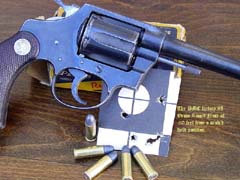
The PMC factory 98-grain round nose at 50 feet from a
seated field position.
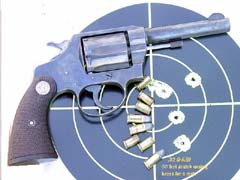
.32 S&W, 50 feet seated, using knees for a rest.
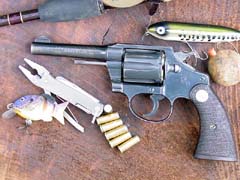
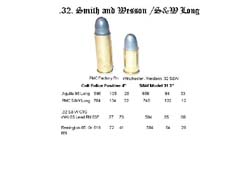
Comparison of .32 Smith and Wesson and .32 S&W Long.
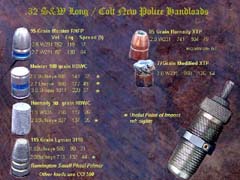
.32 S&W Long / Colt New Police handloads.

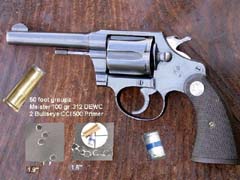
50-foot groups, Meister 100-grain .312 DEWC over 2
grains of Bullseye with CCI 500 primer.
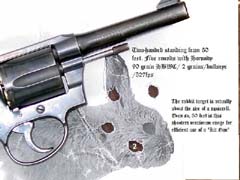
Two-handed standing from 50 feet, five rounds with
Hornady 90-grain HBWC over 2 grains of Bullseye (827 fps).
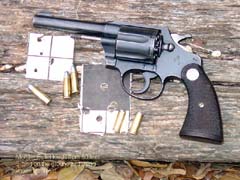
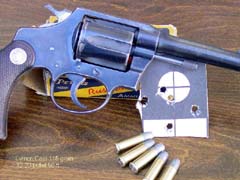
Lyman cast 115-grain .32-20 bullet at 50 feet.
|
![]()